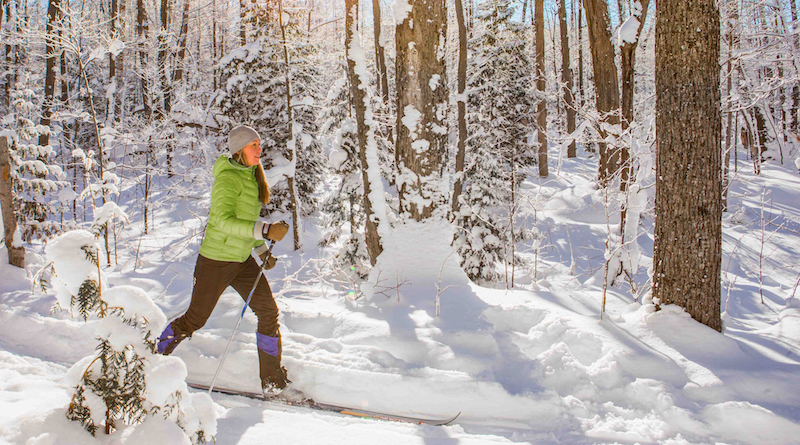3 Ways Cold Weather Can Hurt You
Getting cold can be serious: here’s how to recognize, prevent and treat hypothermia, frostbite and Raynaud’s Disease.
By Dr. Nate Endres
 “Frozen” — it’s my two-year-old daughter’s favorite movie right now. It’s also what it feels like when you get to the top of the chairlift on a cold, windy ski day. In Vermont, many of us enjoy all sorts of winter activities—that’s why we live here. But your body does not ever really acclimate to cold: even those of us who have lived in cold climates our whole lives are as susceptible to frostbite or hypothermia as anyone else. And, cold injuries don’t just occur in winter. In fact, long distance open-water swimmers are among the athletes with the highest risk for cold injuries.
“Frozen” — it’s my two-year-old daughter’s favorite movie right now. It’s also what it feels like when you get to the top of the chairlift on a cold, windy ski day. In Vermont, many of us enjoy all sorts of winter activities—that’s why we live here. But your body does not ever really acclimate to cold: even those of us who have lived in cold climates our whole lives are as susceptible to frostbite or hypothermia as anyone else. And, cold injuries don’t just occur in winter. In fact, long distance open-water swimmers are among the athletes with the highest risk for cold injuries.
Hypothermia
Let’s start with the basics. Body temperature decreases when heat loss exceeds heat production, and most heat loss occurs at the skin. When you start to get cold, your body responds by limiting blood flow to the extremities in an attempt to maintain the core body temperature.
If this doesn’t work, you naturally start to shiver. This is an attempt by the body to increase heat production by firing muscles. If this doesn’t work, you may become hypothermic, which is defined as a body temperature below 95°F. Hypothermia can be further classified as mild (91.4° to 98.6°F), moderate (84.2° to 89.6°F), or severe (less than 82.4°F). Signs and symptoms are:
Mild: Slight to vigorous shivering, fine motor skill impairment, lethargy, apathy, mild amnesia, and social withdrawal.
Moderate: Shivering may cease, cardiac abnormalities may begin, altered vital signs.
Severe: Mental state changes, slurred speech, unconsciousness, gross motor skill impairment.
While we often think of extreme cold weather as being the most dangerous, windy and wet conditions are often just as risky, particularly if your clothing has been soaked by rain, sweat or snow, causing ever more heat loss.
Children, adults over 60 and those with less body fat and muscle mass are more susceptible. Further, if you smoke, drink, are hypoglycemic, dehydrated or simply fatigued, you are also going to be at higher risk.
As with many injuries, prevention is key. Proper clothing is critical, with a focus on multiple layers. The inner layer should be lightweight, wick away moisture from the skin and transfer the moisture to the outer layers, instead of absorbing it. The middle layer is for insulation. The outer layer is for wind and water protection, but should also allow the moisture from the inner and middle layers, to escape. If you are exercising in the cold—say running or skiing uphill—and you work up a sweat you may need to remove layers or change them if they become saturated with water or sweat, particularly if periods of high-intensity exercise are followed by prolonged rest periods or, say, a downhill run after skinning up.
If you think you or someone you know is experiencing hypothermia, try to get to a warm place where all wet clothing can be removed. Patients with mild hypothermia can be rewarmed with insulating clothing or heat-generating devices. In severe cases, heated IV fluids and warmed oxygen may be necessary. If severe hypothermia is suspected, seek medical attention immediately.
Frostbite
Whereas hypothermia is a whole body condition, frostbite refers to the damage caused when isolated tissues freeze. This occurs when tissue temperatures fall below 0°C. Frostbite typically involves exposed skin surfaces, but can definitely affect clothed areas, especially the hands and feet. Frostbite usually occurs gradually, but can also occur immediately if you touch a cold, conductive object, like metal.
Risk factors are basically the same as hypothermia but can be exacerbated with wind chill. If you are wearing tight or restrictive clothing or footwear or using a petroleum lubricant, like Vaseline, you may be putting yourself at additional risk.
Frostbite is classified as superficial or deep. Affected areas may feel numb or burn. The skin may initially look white or red, and swollen. In more advanced cases, the skin may feel firm and blisters may form. Ultimately, the skin may turn black.
If you or someone you know has frostbite, look for any signs of hypothermia. Next, if you can, warm the affected area in a bath ( 104°F to 107.6°F) for 15 to 30 minutes. Note: rewarming should only be started if no more freezing can occur. It is worse for the tissues to undergo a period of warming, followed by freezing, followed by another warming cycle.
The rewarming process can be very painful and Tylenol and/or NSAIDs (Ibuprofen, Advil, Motrin, Aleve) may help with this. Make sure to avoid alcohol and smoking during rewarming
If blood-filled blisters form, they should generally be left alone. In cases of severe frostbite, head to the emergency room. It can takes weeks to months to determine the full extent of tissue damage from frostbite.
Raynaud’s Disease
As I mentioned earlier, the body’s normal response to cold is to limit blood flow to the extremities in order to maintain core temperature. But if your fingers and toes are constantly cold or prone to frostbite, you may have Raynaud’s disease or Raynaud’s phenomenon, a condition where your body excessively restricts blood flow to the hands and feet in response to cold.
Raynaud’s disease can sometimes be very disabling. If you think you might have this, get checked out by your doctor. Certain over-the-counter cold medicines and beta blockers (drugs used to treat high blood pressure and heart disease) can aggravate this. Conversely, your doctor may be able to prescribe a drug to widen or dilate your blood vessels to improve blood flow.
Most importantly, do what you can to prevent getting cold in the first place. If you are out for an extended hike, run, ski or bike and think you’ll break a sweat bring an extra base layer, pair of socks and gloves. While it’s a myth that we lose most of our body heat through our head, keeping a hat and scarf handy is a good idea as it protects the one part of you we often don’t clothe: our heads and faces.
Dr. Nathan Endres, an orthopaedic surgeon and an assistant professor at the University of Vermont College of Medicine, specializes in sports medicine. An avid cyclist and cross-country skier, he treats many athletes in his Williston practice.

